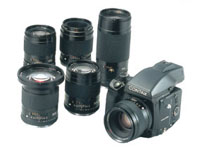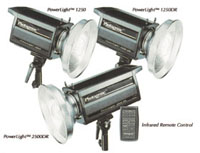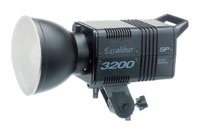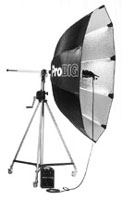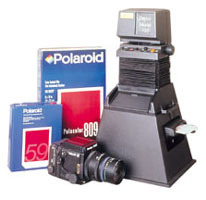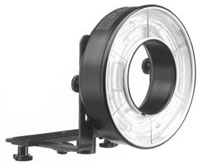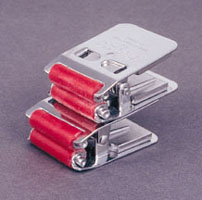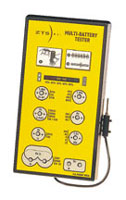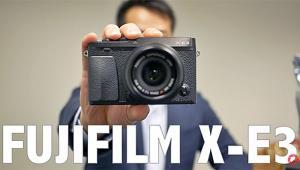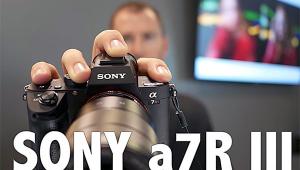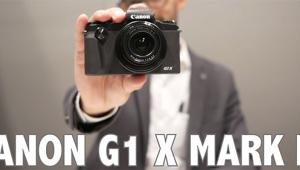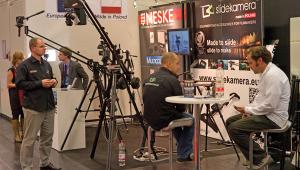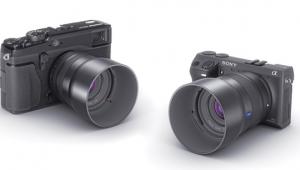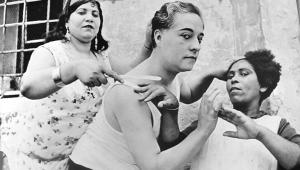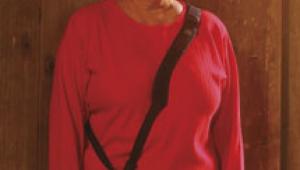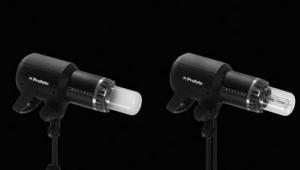PMA International: Medium Format And Studio AC Flash Units
The "new" medium
format cameras shown at PMA '99 were, by and large, the same ones
previewed late last year at photokina and Photo Plus East. The good
news is that those early teasers are now beginning to arrive at your
local dealers as fully functioning production models. |
|||
Mamiya rolled out the Mamiya
7 II, an updated model of their popular 6x7cm format rangefinder camera.
The new refinements include: high-visibility frame lines in the viewfinder
that remain clearly visible even in the presence of intense ambient light;
three strap lugs give the user a choice of vertical or horizontal orientation
of the camera; the cable release socket has been relocated to the more
accessible lower-right side of the body; multiple exposures are possible
via the change-lever system with safety lock; the exposure compensation
operation has been simplified; a ratchet mechanism and flip-out twist
wing for the darkslide curtain facilitate quicker lens changes. The Mamiya
7 II will be available in matte black and champagne gold finishes. |
|||
Photographers who use 6x7cm
cameras have had rather slim pickings when it comes to finding a good
magnifying loupe with which to examine their transparencies and negatives.
Mamiya has improved the situation with the debut of their 3x Cabin Precision
Magnifier. The focusable, three-element loupe covers full frame 6x7. It
comes with interchangeable opaque and translucent skirts for viewing by
transmitted and reflected light, and a removable neck cord. Mamiya also
offers the Pro-Cabin 67 Z projector for 6x7cm transparencies. |
|||
Kiev USA announced two new
perspective control lenses and three new film backs for their Russian-made
Kiev 60 and 88C cameras. The PC lenses are available in 55mm and 65mm
focal lengths, and provide excellent optical performance at a fraction
of the price of similar lenses by other makes. They also fit Pentacon
and Exakta 66 cameras. The film backs are available in 120, 220, and 6x4.5cm
versions, and feature a darkslide storage compartment; the backs fit the
Kiev 88 as well as Hasselblads. |
|||
The other three new lenses
comprise Rollei's new EL-series of more affordable optics. There
are no optical quality shortcuts taken, as they use the same previous
PQ designs. Some recent innovations and manufacturing economies, such
as providing screw-thread filter mounts instead of bayonets, permit the
more user-friendly pricing. The three focal lengths offered cover the
most-used range with 6x6cm cameras. A Rollei 50mm f/4 Distagon HFT EL
consists of seven elements, focuses to 0.9m, and accepts 67mm filters.
The Rollei 80mm f/2.8 Planar HFT EL also features seven elements, focuses
to 0.9m, and takes 67mm filters. The last of the trio is the Rollei 150mm
f/4 Sonnar HFT EL, with five elements, 1.4m close focus distance, and
common 67mm filter size. Bayonet lens hood mounts are retained with the
EL lenses. |
|||
The Rolleivision 66 dual P
slide projector was on display, a fully automatic, autofocus 6x6cm machine
that can also project 35mm slides (not intermixed). Two projectors can
be paired with an external control unit for programmed AV dissolve presentations. |
|||
Another nominally medium format
item from Polaroid was a new single-use instant camera dubbed PopShots.
The compact, ergonomically shaped camera produces 10 4.4x2.5" color
prints. To take a picture, the user simply throws a bright yellow switch
to an indoor or outdoor setting (flash/no flash), composes the scene in
the viewfinder, presses the shutter release, then pulls a ring on the
side of the camera to eject the externally developing print. PopShots
features two apertures (f/32 outdoors; f/13.4 with flash), variable shutter
speeds, and real-time exposure metering. How will Polaroid encourage people
to recycle these instant cameras? By packaging a postage-free return mailer
with the camera; by entering all returns in a sweepstakes that offers
prizes such as CD players and a trip for four to anywhere in the world;
and a $2 coupon good for PopShots or other Polaroid products. A $4 rebate
is offered to customers who return the $19.99 (list) camera for recycling. |
|||
NPC has announced availability
of a new Proback for the recently introduced Pentax 67 II. The Proback
allows use of Polaroid proofing films, and does so without compromising
any camera features, or having to transfer any camera controls to the
back of the Polaroid film chamber. It is no longer necessary to pre-cock
the shutter before attaching the Proback, as it was with the previous
Pentax 67. The focal plane is shifted to that of the Proback via a fused,
coherent fiber optic bundle. It produces a full 6x7cm contact image. Due
to the design of the 67 II body, a new, double live pin hinge must be
installed. |
|||
Brandess/Kalt/Aetna (BKA) is
now the US distributor for the Bowens Esprit line of monolights, and is
introducing a new consumer promotion on their Excalibur monolights from
SP Systems. When purchasing an Excalibur 1600 (160 ws) or 3200 (320 ws),
BKA will give you a free 8', air-cushioned light stand, and a copy
of the SP Studio Systems Handbook. The book contains a wide range of pro
tips on various lighting setups, including product and glamour photography.
The Excalibur flashes are affordable units designed for the advanced amateur
and beginning professional. |
|||
Also shown was Elinchrom's
Octa-Lite Pro Bank. This new stand-alone softbox consists of a EL 500C
Compact monolight and remote photo cell, coupled with a 74" diameter,
40 sq ft octagonal softbox. It integrates easily with other brands of
flash systems, sets up in two minutes, and offers the following performance
characteristics: less than 1/3 stop light falloff across the entire softbox
diameter; 500 ws output (f/16 at 6', ISO 100); power output infinitely
variable down to 1/4 power; 1/2600 sec flash duration; full power recycling
time of 1.6 sec; consistent color temperature throughout the power range.
The OctaLite provides a lovely "wrap-around" light quality. |
|||
In addition to the UltraZAP's
list of improvements, the X-Series, consisting of the X1600 (660/165 ws)
and X3200 (1320/330 ws) models, adds the following: power range switching,
which allows cutting 3/4 of the unit's power, for situations when
a wide aperture or very short flash durations are needed (the modeling
lamp intensity is reduced proportionately); a built-in cooling fan that
automatically kicks in when internal temperatures warrant; audible overheat
alarm; audible misfire alarm. And these are just the improvements, not
a full inventory of features and capabilities. |
|||
Photogenic launched its PL2
Series monolights, offering photographers an affordable option to set
and control their lighting setups from a handheld remote unit or a computer
screen. The PL2 Series lights include the PowerLight 1250 and 1250DR (500
ws), and the PowerLight 2500DR (1000 ws). The potent 2500DR offers infinite
power variability from 32 ws to 1000 ws, which is a full six f/stop range.
It also features push button control and a digital display for the flash
and modeling lamp. Both DR models accommodate exclusive add-ons that enhance
power, control, and versatility. One such accessory is a Digital Remote
Display and IR Receiver with touch control, which allows changing your
settings without having to lower boom-mounted lights, or attempt accessing
other inconveniently located lights within a set. Another boon is the
IBM and Mac compatible Wireless Studio System Software. This lets you
control your entire lighting setup from one centralized location, from
a desktop computer or, for location work, a laptop. It can control up
to nine PowerLights, and save files for every setup for future reference
or duplication. |
|||
AddMamiya America had some
new items in their Profoto electronic flash line. A pair of compact but
heavy-duty flash generators (power packs) are the Profoto Acute 12 (1200
ws) and Acute 24 (2400 ws). Accepting three flash heads, power can be
distributed symmetrically or asymmetrically for various lighting ratios.
The head connections are arc-proof, and the packs can be plugged in to
any worldwide voltage from 90-260v. Regulated voltage assures constant
color temperature. The packs also feature a unique variable rate recharge
dial, allowing the photographer to steplessly adjust the voltage draw
and thereby avoid blowing fuses and circuit breakers when on location
with inadequate or old wiring. The units are also well sealed. The Acute
Head Special lamphead is fan cooled and comes with a zoom reflector. |
|||
For those occasions when a
direct window lighting effect is sought (sans window), Profoto has a unique
tool: the Profoto ProBig, a portable, folding, parabolic, focusable reflector.
With "Big" underlined, the reflector measures 7'2"
(86") in diameter when opened; it weighs 17.5 lbs, or 22.5 lbs in
a transport bag with an accessory diffuser and swivel mount. An adjustable
lamphead mount allows focusing the light for different effects and spreads.
It accepts Acute and other Profoto heads. When trying to create soft,
natural light there's no substitute for size, which makes the ProBig
just the ticket. |
|||
It was in the area of the show
devoted to industrial film and print processing equipment that I stumbled
upon the Privett International booth. Their display featured a large selection
of beautifully made film clips designed for "dip-and-dunk"
film processors. While they have models with traditional teeth for grasping
film leaders, it was a line dubbed "soft-jaw" that caught
my eye. Anyone interested in them for their intended purpose will be more
than pleased, but another use came to mind. When adjusting muslin and
other fabric backgrounds for portrait shoots, I often need to clip one
or more heavy fabrics into position relative to one another. My previous
solution was the orange- handled, chrome "pony clamps" available
at hardware stores. However, the Privett Soft Jaw clips are available
in single, double, and quadruple clip models in several different configurations,
which would let me clamp several fabrics or folds at a common spot. There's
also a single model with a hook that could hang from a support rod or
line. Tension is very firm, yet the silicone rubber roller jaw faces won't
tear the fabrics. This type of rubber will even survive Los Angeles'
industrial strength air without disintegrating. You can probably think
of more possibilities in your own work. |
- Log in or register to post comments
